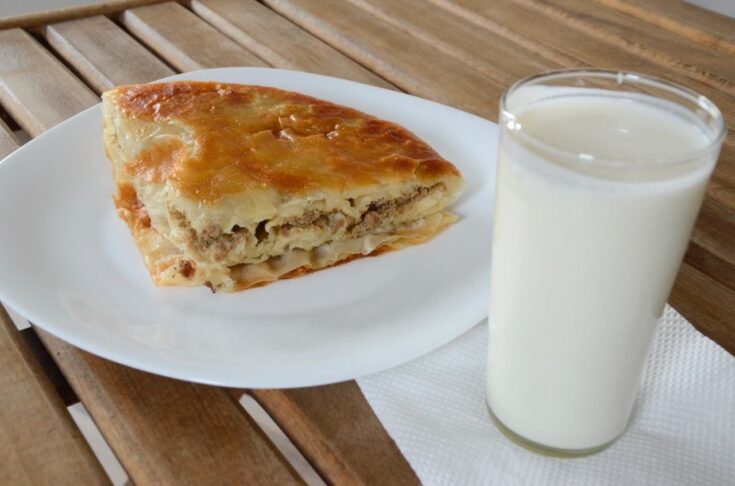
Easy Croatian Burek Recipe
You can't miss trying burek when in the Balkans - and you'll fall in love. So, here is an easy to make Croatian burek recipe.
Ingredients
Burek Dough:
- 500g all-purpose flour (3.5 cups)
- 1 teaspoon of salt
- 300-350mls lukewarm water (1 1/4 - 1 1/2 cups)
- Vegetable oil
Burek Cheese Filling:
- 150 g cottage cheese (2/3 cup)
- 100 g crumbled feta cheese (2/3 cup)
- 1 large beaten egg
Meat And Potato Filling:
- 1 tablespoon of olive oil
- 1 medium, diced onion
- 300 g lean beef mince (10 oz)
- 1 potato, boiled cut into small cubes
- 2 grated garlic cloves
- Half teaspoon chopped rosemary, fresh is best
- Half tablespoon smoked paprika
- Half tablespoon salt
Instructions
How To Make Burek Dough:
- Take a large bowl and combine the flour and the salt
- Add the water bit by bit, mixing until the mixture forms a dough
- Knead the dough for around five minutes, until it turns quite stretchy
- Split the dough mixture into batches of four and press down to flatten
- You need to find a bowl or a pan which is large enough to hold the dough when it is piled up on top of each other
- Add a little bit of vegetable oil to the pan or bowl and put the first flattened piece of dough inside
- Add a bit more oil (not too much), and add another piece of dough – repeat until you’ve done the same with all four pieces
- Add more vegetable oil on top of the last piece and place to one side to rest
- Preheat your oven to around 200°C (390°F)
- Add a little vegetable oil over your work surface (a table is best) – just a little!
- Remove one piece of dough from the bowl and remove the excess oil
- Flatten the piece of dough until it reaches a thickness of no more than around half a centimeter
- Handle the dough and stretch it outwards, over and over, so that you pull it to around 1 meter in diameter – you might end up with a few holes but don’t worry about it too much. By the end, you should be able to see through the dough
- Take one side of the dough disc and fold it over, towards the center
- Repeat this process until you have a shape that resembles a pentagon
- Repeat with the second piece of dough
- Add your filling (see below for the filling instructions) to the dough piece
- Add the first piece of stretched dough into the middle of the second one, and cut away the thick edge of the second piece – you can throw this away, you won’t need it
- Fold over the edges of the dough, so that you get a pentagon shape once more, and put it into a baking pan or tray
- Put the pan in the oven and bake for around half an hour, until it is a golden color
- Remove from the oven and let it cool down
- Cut into 12 pieces
- Repeat the process with the rest of the dough
- Bake until the pastry turns golden, and serve while warm!
For The Cheese Filling:
- Take a mixing bowl and add in both kinds of cheese, combining together
- Add the egg and combine once more
For The Meat & Potato Filling:
- Take a large pan and heat up the oil over a medium heat
- Add the onion and cook until soft
- Now, add the mince and cook for around 2 minutes, stirring regularly
- Now, add the potato, the rosemary, the garlic, and the paprika, and stir to combine
- Add the salt and continue to cook, ensuring the beef mince is cooked through
- Once cooked, drain the beef with a sieve to get rid of any excess oil and press down to dry it out
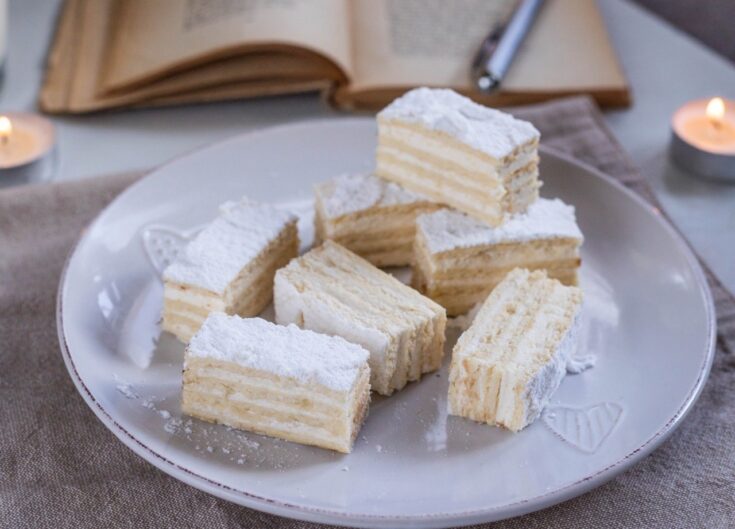
Bijela Pita Recipe (White Slice)
Bijela pita is a traditional cake in Croatia and several other countries in the Balkans. Here is an easy to make bijela pita recipe, this Croatian white slice is sure to please.
Ingredients
The dough:
- 400 g flour (2 3/4 cups)
- 100 g sugar (0.5 cup)
- 120 g lard (2/3 cup)
- 1 egg
- 1 teaspoon baking powder
- 4 tbsp milk
The filling:
- 500 ml milk (2 1/4 cups)
- 3 tablespoons flour
- 150 g sugar (3/4 cup)
- 1 tablespoon vanilla essence (or 1 packet vanilla sugar)
- 100 g butter (7 tablespoons)
Instructions
- Mix all the dough ingredients, to make a ball of dough. It should be smooth and soft
- Shape it into a ball, leave it in a bowl, and cover with cling film and let it rest in the fridge for at least half an hour
- Divide the dough into 4 same-sized pieces and, using a rolling pin, roll them out around 3-4 mm thick
- Bake the 4 pieces of dough in a pre-heated over (180°C/350°F) until they are slightly golden on the edges.
- Transfer to wire racks and let the sheets cool down. Hot tip: One trick before baking the sheets, is to use your tray as a template and cut the 4 rolled out sheets to the exact size/shape - this makes the final assembly much fast, easier and neater
- In a saucepan heat, the milk with sugar and vanilla sugar. Add the flour slowly while constantly stirring. Cook until the mixture starts to get thick (it will take a few minutes). Set aside to cool.
- When the filling has cooled down, add in the butter, and with an electric hand mixer, mix until you get a soft cream-like texture
- Now we need to start assembling this delicious dessert. Place the first sheet of pastry put on a tray and cover with 1/3 of the filling. Spread the filling evenly before putting on the second layer of the pastry.
- Continue to do so until you have used all 4 sheets and filling. Simplified: pastry-filling-pastry-filling-pastry-filling-pastry
- Dust with powdered sugar and let it rest in a fridge overnight
- Slice it and serve it the next day
Notes
The reason for letting the slice rest overnight is so that the pastry has time to soften and is easier to slice.

Baklava Recipe (Baklava s Orasima)
Rich in flavor, juicy and sweet, a real calorie bomb that is hard to resist. Here is how to make baklava with walnuts.
Ingredients
For The Main Part
- 500 g phyllo pastry sheets (1lb)
- 800 g walnuts, whole (6 cups)
- 300 g butter (1 1/3 cups) or you can use or vegetable oil
For The Agda
- 800 g white sugar (4 cups)
- 800 ml of water (3 1/3 cups)
- 3-4 lemon slices
Instructions
This is one of the few recipes where we don’t start with making our own pastry, as with these we'll use the store-bought phyllo sheets as it’s used in the Balkans. Instead, we'll first start with making the agda.
- Mix the sugar and water in a pot, a place on high heat uncovered
- Once it's boiling, watch the clock - after boiling for approx 6-8 minutes, you can add one or two lemon rings, remove the pot from the stove, place on the lid, and allow the agda to cool completely
- Take the whole walnuts, and grind them in an electric chopper. I prefer this method, as I can easily control the size of the ground nuts. Baklava tastes better if you have both, finely ground walnuts as well as some bigger pieces in it
- Now, we'll need to clarify the butter. If you're using vegetable oil, you can skip this step. Place the butter in a pot and heat it over medium heat. Once the white foam appears on the surface, remove it with a spoon and discard. Do not stir the butter. After a few minutes, the butter will become clear, a white sediment will form at the bottom of the pot. Remove the pot from the stove and pour the yellow, clear portion into another pan and throw away the white precipitate (milky substance) at the base. It's important to clarify the butter to avoid black spots appearing on the baklava while it bakes
- Cut the phyllo sheets to the size of your baking tray. I cut my sheets in half, as I used the smaller tray and therefore had 20 phyllo sheets for layering. If your tray is for 2/3 the size of sheets then you can also use two smaller pieces to make one layer (it doesn’t matter if they overlay)
- Grease the tray with a little butter and put the 1st sheet inside, using a pastry brush, coat the pastry sheet. Repeat this step for the 2nd, 3rd, and 4th sheets remembering to brush each sheet
- Spread some of the walnuts on top of the 4th sheet
- Add 2 more layers of brushed phyllo sheets, and spread more walnuts over them
- Continue until you're left with 4 sheets of pastry. Grease the 3 last layers - but not the last sheet
- It is important not to grease the last phyllo sheet as this last sheet, will need to be pre-sliced before baking. If you were to grease the last sheet, it would be very difficult to make straight cuts
- Place the last sheet on, and then using a very sharp knife, cut the baklava into strips of the same size. If you are making squares, rotate the tray 90 degrees. If you would rather make rhombuses, rotate it 45 degrees. I made the slices to the pastry by being very careful. You could also use a piece of paper or cardboard to make it easier and precise. Refer to the photos to make it easy to understand
- Grease the top phyllo sheet and place the baklava in a preheated oven at 180°C (350°F), and bake for approx 30-35 min
- When the baklava has turned a golden yellow hue, remove it from the oven and pour over the cold agda
- Cover it with a wet kitchen cloth. I suggest you place 2 wooden sticks or wooden spoons across the tray, before placing over the wet cloth to prevent it from sticking to the top layer
- Allow the baklava to soak up the agda and cool overnight
- Once cooled, if the top layer has curled, you can remove the first layer and discard
- Serve with a strong cup of coffee!
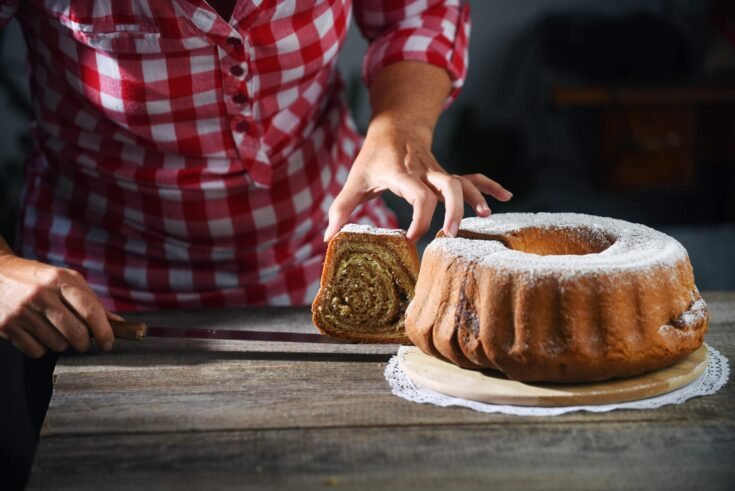
Walnut Potica
Here is how to make Slovenian walnut potica. This orehova potica recipe takes a little time, but the results are well worth the wait! Try it now.
Ingredients
Dough
- 400 g (3 cups or 14 oz) soft pastry flour
- 200 g (1 ¼ cups or 7 oz) strong bread flour
- 42 g (1.5 oz) fresh yeast
- 100 g (½ cup or 3.5 oz) sugar
- 300 ml (1 ¼ cups or 10 fl oz) lukewarm milk
- 4 egg yolks
- 8 g (0.3 oz) vanilla sugar
- 1 tbsp rum
- ½ lemon, zested
- 5 g (0.2 oz) salt
- 50 g (1.8 oz) butter
Filling
- 300 g (11 oz) shelled walnuts
- 200 ml (¾ cup or 7 fl oz) milk
- 10 g (0.4 oz) vanilla sugar
- 120 g (5/8 cup or 4 oz) sugar
- 100 g (3.5 oz) butter
- ½ lemon, zested
- 2 tbsp rum
- 1 egg white and 15 g (0.5 oz) sugar for whipped egg white
You Will Also Need
- Butter for buttering the mold/potičnik
- Strong bread flour to facilitate the dough rolling process
- Caster sugar and a thin wooden stick
Instructions
Place the eggs and yeast at room temperature at least half an hour before baking. Sift the flour into a mixing bowl (I prefer plastic bowls) to make it lighter and airier in texture. Mix gently to ensure both types of flour are well-integrated. Don’t use a bowl that is cold to the touch, as it will interfere with the quality of your leavened dough.
Yeast Mixture
Crush the yeast into a small bowl, add one teaspoon of sugar, 4 tablespoons of lukewarm milk, and 1 tablespoon of sifted flour. Stir gently, cover the bowl with a dishcloth and allow the mixture to rise at room temperature until it doubles in size, about 10 to 15 minutes. In cold weather, set the mixture in a warm place to expedite fermentation.
Egg Yolk Mixture
Beat the egg yolks, sugar, vanilla sugar, rum, lemon zest, and salt into a fluffy mixture before adding lukewarm milk to it.
Melt the butter and allow it to cool so it’s not too hot when mixed with the flour.
Return to the bowl of sifted flour and form a depression in the center, then pour in the yeast mixture. Use a wooden spoon to slowly fold the flour from the edges into the yeast mixture.
Now add the egg yolk mixture and stir again before putting in the melted butter.
Please take 20 minutes to knead the ingredients until they form a soft, silky texture that doesn’t stick to your hands or the bowl.
Add some strong bread flour, if necessary. Then form a loaf, cover it with plastic wrap and allow it to rise to twice its original size—about an hour to an hour and a half.
For best leavening results, keep the room temperature above 25°C/77°F.
In the meantime, prepare the filling. First, grind the walnuts. Add vanilla and regular sugar to milk and bring everything to a boil for the sugar to dissolve. Then pour the milk over the ground walnuts.
Melt the butter in a smaller pan and add it to the walnut mixture while still hot.
Mix the walnut concoction well and allow it to cool before adding lemon zest and rum to it.
Beat the egg white with sugar and a pinch of salt until stiff and mix it carefully into the walnut mixture.
Prepare the work surface by laying a larger dishcloth over it, then sprinkle some strong bread flour evenly across it.
Place the dough on the dishcloth and roll it out to form a square that is 1 finger-width thick (1 cm/0.4 inch).
Once rolled, the dough should measure 55x55 cm (21x21 inches) in size, which is a perfect fit for a 27 cm (10 inches) potičnik.
Spread the filling evenly to the edge of the stretched-out dough. Begin rolling up the dough from one side, gently pulling on the emerging tube to ensure the flat dough ahead is taut.
Use fingers while rolling up the dough to squeeze out trapped air to prevent air bubbles from forming during baking. Pinch in the side edges as you go to avoid filling-free bites. Continue until the dough is rolled up.
Butter the potičnik and use a kitchen cloth to determine the length of the dough to match the circumference of the potičnik.Feel free to cut away the edges as necessary to ensure a proper fit. Place the dough into the potičnik.
Use a thin wooden stick to poke holes through the dough to facilitate air expulsion, then cover it with a dishcloth and set it in a warm place for another one-hour leavening session—Preheat the convention oven to 180°C/350°F.
Perforate the dough again, put it in the oven and bake for one hour. If the crust turns yellow before the end of baking, cover the potica with baking paper; otherwise, keep the oven closed the entire time.
When baked (check by inserting a knife blade into the dough—it’s done when the blade is clean), take the mold out of the oven and immediately flip it over, so it slides out. Allow it to cool, preferably on a wooden surface, then sprinkle caster sugar over it.
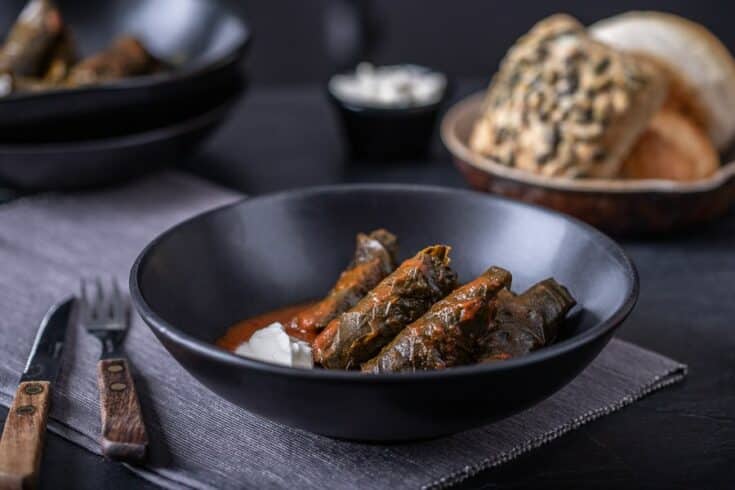
Japrak Recipe (Stuffed Vine Leaves)
Yaprak dolma, yaprak sarma or just simply yaprak are originally a Turkish dish. Yaprak is a Turkish word meaning “leaf” so it basically means it’s a stuffed leaf and in this easy-to-make Balkan recipe we show you how to make stuffed vine leaves.
Ingredients
- 40 vine leaves
- 400 g minced beef meat
- 1 red/purple onion
- 100 g rice
- salt, pepper and red paprika
- 500ml tomato sauce
- 200ml water
Instructions
- Wash out the vine leaves and cut off the stem
- Season the minced meat and mix it with the rice and finely chopped onion
- Place one vine leaf on a flat surface with the inner side turned up
- Use a spoonful of the meat and rice mixture, shaped into a cylindrical form, and place it onto the edge of the leaf
- Fold in both sides of the leaf and then fold up the bottom of the leaf over the mixture, then roll the leaf upwards, sealing in the mixture
- You will end up with little “vine leaves cigars.”
- Tightly pack the rolls in a deep saucepan (this will help them to stay closed during cooking)
- Cover the rolls with a mixture of tomato sauce and water
- Set a plate on the top so the rolls – this will ensure that they do not move during cooking and unwrap
- Cook for around 30 minutes on a medium heat
- Serve these easy-to-make stuffed vine leaves served with a dollop of sour cream while hot.

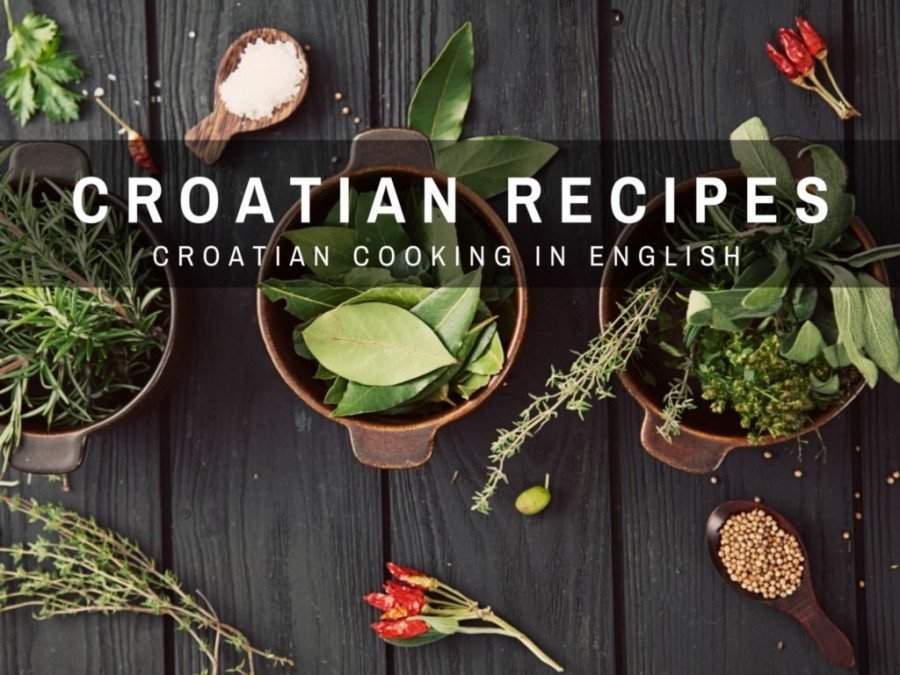
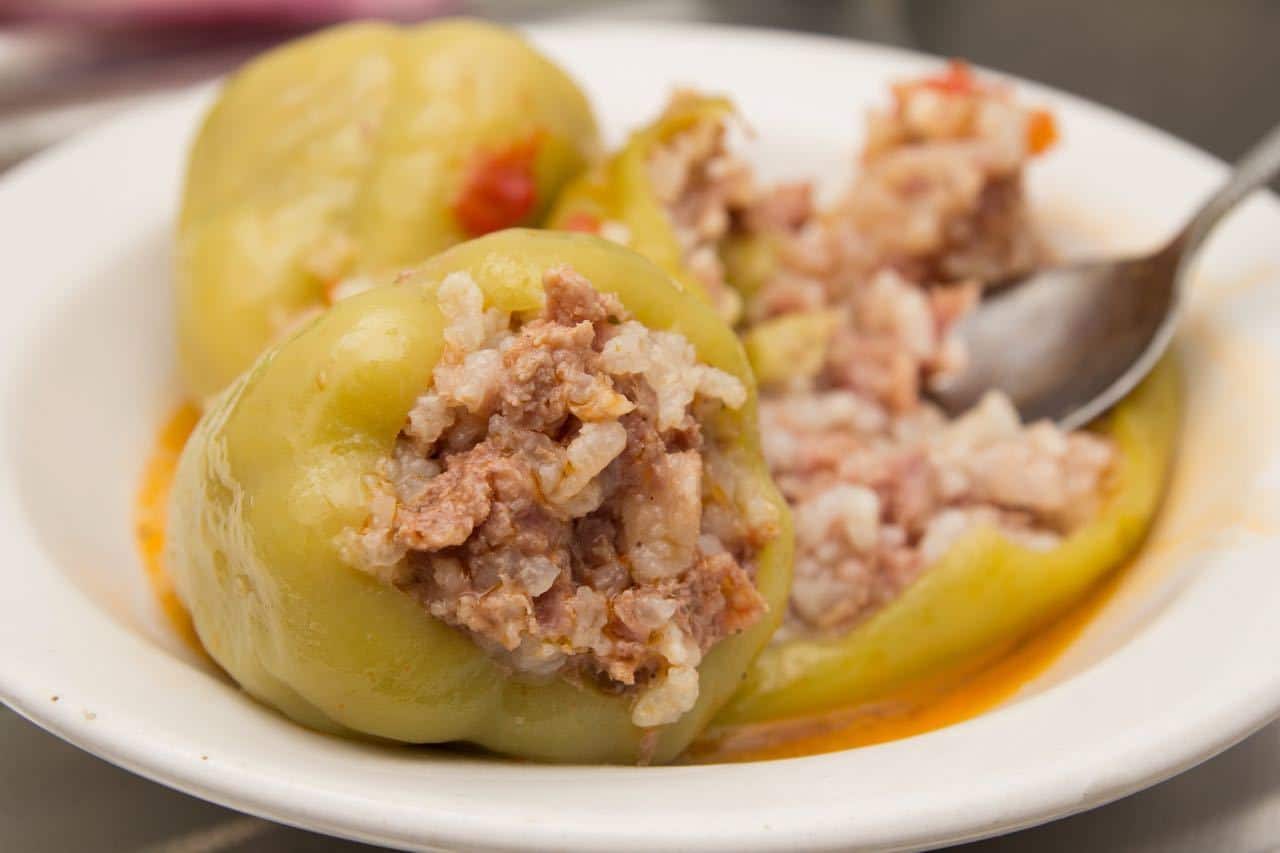
Traditional Baka style foods
Like Rabbit Stew?
We have and also
You guys should definitely do a grah recipe and that spinach soup that’s made with milk and lots of garlic that I can’t remember the name of right now
Hi,SJ and mate,Croatia is very beautiful and attractive country. I’m living in the Japan. Olive trees are being grown by a hobby. Only one olive of Croatian origin is being also brought up. I also like Australian olives. Jumbokalamata! But it isn’t possible to get in Japan. I’d like to bring up sometime,my dream.
wow! Croatian food looks so delicious. Your photos make me want to eat it now. thanks for sharing and i want you to post many posting like this. your posting make me know more about traditional in croatia :D
I need help with Bosnian measurements – would like to find Bosnian measuring utensils to purchase for my friend so she would not have to convert her recipes to American measurements while cooking
I have no clue what Bosnian measurements even are? Sorry Natalie.
Metric
Croatian food looks delicious. i love it.
Is there a recipes for Dubrovnik style pasta in dak orange and wine please? Like is served at Mala Kuzina?
We do not have one, but we will see if we can find one for you :D
My grandmother came from what is now Rijeka, when I was little my Dad would make these incredible noodles she had taught him, they were wide and flat, and I swear they were just flour and water. When I tell people that they always say, “that’ glue.” It’s not glue. Anytime I’ve asked him to teach me how to make his noodles, he just pushed me out of the way and made them himself. Is there a name for this type of noodle? His mom died when my Dad was eight so he doesn’t know it.
I am sorry, I have no clue. I wish I knew…
Are they mlince?
That sounds like Mlince….was it eaten with turkey?
Is that the flatbread with the turkey drippings on it? Been trying to find a recipe.
It sounds like you’re talking about mlinci ????
5 from 1 vote
Croatian Mlinci Recipe
Croatian mlinci is best described as broken pieces of thin, homemade flatbread that is baked in the juices of a roasted turkey (pork or duck).
Course: Side DishCuisine: CroatianKeyword: croatian, noodle, side dish Servings: 10 People Author: Jane and Sonja
Ingredients
6 cups flour all purpose
1 tbsp salt
1 egg
5 cups water divided
2 cups juice from roasted turkey or duck or pork
1 tbsp Vegeta
2 tbsp butter
Instructions
Mix these ingredients well until dough is ready to knead by hand for 2 minutes. Has to have the same texture as bread dough.
Remove and divide into 10 pieces.
Working one piece at a time, roll out the dough thin.
Preheat the oven 365F.
Transfer rolled out dough onto the middle rack in the oven.
Bake for 7 minutes, turn and then bake another 4 minutes to give color to both sides.
Tip – Place foil on the lowest rack to protect the oven from loose flour.
Remove from the oven and place on a tea towel lined counter top. Leave to cool completely. Can be prepared the day before.
Repeat for remaining dough.
When cool, break into smaller pieces and place in a large bowl.
Boil 2.5 cups of water and pour over top.
Cover with clean dish cloth.
Let sit for ½ hour.
Pieces should be soft but not mushy. If hard, add a bit more water and let sit again. Steam will help to soften the pieces.
Usually prepared with turkey (duck or pork roast). Save grease from baked turkey. Remove turkey from pan and use the same pan used to cook turkey for the mlince.
Combine turkey grease (need about 2 cups of grease from turkey) with 2 tbsp butter, 1 tbsp Vegeta. Need enough sauce to cover mlince.
If not enough grease from meat (will need 2 cups of liquid), add hot water with more butter and Vegeta.
Place back in the oven to cook for another 20 minutes on 365F. Cook uncovered.
Stir and serve.
Aug 2022-
I like this site but growing up in northern Minnesota where many Croatians live I never had most of your foods listed on this site
This part of Minnesota is the Iron Range and a big melting pot
Immigrated years ago:
( Croatians Sylvakia Italians Slavs Swedish Norwegian Germans …)
First yr for all Balkan Slav experience weekend in
Mpls Mn- rep E Europe- about 13 countries Aug 20-21
I did see dif dumplings there
The iron range has its own
I would really love the recipe for Zagrebački Kolač in English. I has this in a small patisserie in Varaždin & still can’t stop thinking about it.
I can see why… yummmo
Napoleon, Balkans style
Ingredients:
250 g puff pastry
4 eggs
100 g corn starch
30 g all purpose flour
3 x 100 g sugar
2 sachet vanilla sugar
750 ml milk
300 ml water
250 ml heavy cream
Directions:
1. Roll the puff pastry into two sheets fitting smaller rectangular pan. Poke a few holes on the bottom of the dough with a fork and bake each sheet in the oven preheated to 180°C for about 10-12 minutes or until golden. Leave one sheet in the pan for the base, cut another into serving size squares.
2. Beat egg whites with 100 g of sugar very stiff. Mix egg yolks with another 100 g of sugar, add vanilla sugar, corn starch, flour and water.
3. Boil milk, stir in the yolks cream and cook over lower temperature until it becomes very thick. Remove from heat and carefully whisk in the egg whites foam. Pour the filling in the pan with pastry sheet at the bottom.
4. Beat heavy cream with 100 g of sugar and spread over cooled filling. Arrange the pastry squares over. Cool. Dust with icing sugar before serving.
Ohhhh yummy! Can we post this on the blog? It looks so easy… I bet its not though
Yum
My aunt in Split used to work in a bakery store and gave my mum a vanilla slice recipe. Everyone in the family and friends always request her to make a tray when there is a special occasion.
… ok share it with us and we’ll glad make your Mama and Teta famous :D
Can I pls have the recipe???
Actually going to try the Cro restaurant in Williamstown if I can this weekend. They have more traditional stuff on the menu than the Dom in Footscray.
i have a hankering for some bbq calamari!
My kids have been there many times. They love it. It’s an up class Croatian cuisine. The tradition Cro food is good at Footscray Croatian dom. Whitehall road ( I think). Love their sarma and chicken soup. Plenty of bread. ????
The Dom has hardly anything on the menu. Last time we visited, everything Peter asked for, he was told we don’t have it. He had to order cevapi because they had nothing but those or fish!
Its a good excuse to drink…
Hi my mum& dad we’re from Croatia and have recently passed away. I have all of mums recipes, but they are all in Croatian & I can’t read them :(
Do have a recipe forBuhtle ?
I’m loving your recipes thank you
Where can I buy a pekar bell?
Benkovac markets sells them in you live in/near Zadar.
When ever we travel to Croatia (Zadar) my mother prays i take over the lunch duties but i just struggle and stress over not finding equivalent ingredients.
Could you please let me know what the cut of meat Gravy Beef is called over there as i use that cut alot here in Australia,also do they have chicken spare ribs over there,and self raising flour ????
Sorry, I have no idea what gravy beef is. Also, what are chicken spare ribs (sounds gross). Here the butcher has the whole animal, so, you just tell him what you need and they cut it – so just tell him what you want to make and he will give you what you need. Yes, self-raising flour can be found (look for the green packet).
Hello, I’m trying to translate an old recipe for a no bake Chocolate Rolada with a cream filling. The recipe uses “dk” as a measurement (e.g. 10 dk powdered sugar). Does anyone know what this means and what the metric conversion is?
Thank You!
Susie
Could it be decagram? A decagram is a metric unit of mass equal to 10 grams. The symbol of the decagram is dag. To convert decagrams to g, dg, cg and mg, multiply by one followed by as many zeros a
1dk is 10 grams. In Croatian you call it deka.
Hi, I’m an Australia born Croat who grew up on Croatian food. My mum has long since past and I realised recently that she never showed me how to cook her Ucipke recipe she was Dalmatian and I’m not sure that this is what there called throughout Croatia. They were a sort of dumpling, it was a dough that you dropped spoonfuls into hot oil till they puffed up and were golden you then tossed them in sugar my son loved them but I can’t remember what went into the dough, can you help ?
What you may mean are fritule – is this them?
https://www.chasingthedonkey.com/croatian-cooking-mamas-fritule-recipe/
Fritulje?
We call them Ustipci! It’s super simple, like making crepes, but you need the mixture to be slightly thicker. Milk, flour, eggs, a bit of salt and some people add a bit of sugar too. Top them with sugar, jam or even Nutella! And that’s it!
Just seeing this for the first time and was interested for two reasons:
1. My mother-in-love’s parents immigrated from Croatia/Yugoslavia in the early 20th century, and;
2. Our youngest son and family just finished two-years as missionaries to Prague.
Mom and her family were very close, especially during the holidays. At Easter, the big treat was Mom making Jaludas and Povitica. I helped her many Easters and she taught me how to make it as I helped. She was such a blessing to this new bride and I have been able to teach it to our children to honor Mom and her heritage. I’d love to know more about these two dishes and their history. If the are “forgotten” or “lost” from the current culture, I would be happy to share with you. As an aside, we were being “sent” to Prague by our children last summer in honor of our 50th Anniversary in order to allow us to sightsee before the kids came home. Covid threw a big wrench into all that but I also believe God was watching out for us and directing our paths out of harm’s way. It’s still on our “bucket list” a long with Norway (my paternal heritage). Thank you for sharing your recipes and life with us. I look forward to hearing back from you!
God bless you all & keep you safe!
Cathy Post
Dobar Dan Anna (Good Day Anna), there are quite a lot of Croatian cooks on youtube you may be able to locate the recipe there. Hope you find the recepie.
I am interested in obtaining a Croatian cookbook. I am Croatian and Slovenian.
Dobar Dan Anna (Good Day Anna), there are quite a lot of Croatian cooks on youtube you may be able to locate the recipe there. Hope you find the recepie.
I’m looking for a reship recipe called cummala I’m sure I’m spelling it wrong.i sure hope you know what I’m talking about thank you